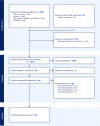How is maternal employment associated with infant and young child feeding in Bangladesh? A systematic literature review and meta-analysis
- PMID: 39854519
- PMCID: PMC11759378
- DOI: 10.1371/journal.pone.0316436
How is maternal employment associated with infant and young child feeding in Bangladesh? A systematic literature review and meta-analysis
Abstract
Background: In the last three decades, the increasing trend in female employment in Bangladesh has been critically analyzed from a socioeconomic point of view; however, its impact on infant and young child feeding (IYCF) practices has yet to be systematically reviewed. The aim of this systematic review and meta-analysis is to investigate the association between these variables.
Methods: A systematic literature search was conducted in PubMed, Medline, Web of Science, Embase, CINAHL, and Google Scholar to retrieve relevant records with no restriction of publication period. The Covidence tool was used for screening and data extraction. Meta-analysis was carried out using random effect models. The Newcastle-Ottawa scale was used for the quality assessment of the included articles.
Results: A total of 24 articles were included. Of these, 16 focused on breastfeeding-related indicators, 6 focused on complementary feeding-related indicators, and 2 focused on both. Maternal employment was found to have both positive (protective) and negative (detrimental) associations with exclusive breastfeeding, whereas it was mainly positively associated with complementary feeding practices. Meta-analysis showed the pooled odds ratio of recommended early initiation of breastfeeding, exclusive breastfeeding, and complementary feeding among employed mothers were 0.79 (95% CI: 0.49, 1.27; p = 0.33), 0.32 (95% CI:0.16, 0.67; p = 0.002), and 1.07 (95% CI: 0.81, 1.42; p = 0.63) compared to their counterparts, respectively.
Conclusions: Maternal employment appears not to be a protective factor for some important breastfeeding indicators in Bangladesh. For example, there was a statistically significant lower likelihood of exclusive breastfeeding practice among employed mothers as compared to those who were not employed. Therefore, these issues should be taken into consideration when formulating relevant policies and interventions, e.g., breastfeeding-friendly workplace.
Copyright: © 2025 Rifat et al. This is an open access article distributed under the terms of the Creative Commons Attribution License, which permits unrestricted use, distribution, and reproduction in any medium, provided the original author and source are credited.
Conflict of interest statement
The authors have declared that no competing interests exist.
Figures




Similar articles
-
How is parental education associated with infant and young child feeding in Bangladesh? a systematic literature review.BMC Public Health. 2023 Mar 17;23(1):510. doi: 10.1186/s12889-023-15173-1. BMC Public Health. 2023. PMID: 36927525 Free PMC article.
-
The effect of unemployment and post-natal care on the exclusive breast-feeding practice of women in Ethiopia: a systematic review and meta-analysis.Reprod Health. 2022 Apr 15;19(1):94. doi: 10.1186/s12978-022-01404-y. Reprod Health. 2022. PMID: 35428313 Free PMC article.
-
Determinants of infant and young child feeding practices in Bangladesh: secondary data analysis of Demographic and Health Survey 2004.Food Nutr Bull. 2010 Jun;31(2):295-313. doi: 10.1177/156482651003100220. Food Nutr Bull. 2010. PMID: 20707235
-
Working women, maternity entitlements, and breastfeeding: a report from Bangladesh.J Hum Lact. 1995 Dec;11(4):273-7. doi: 10.1177/089033449501100413. J Hum Lact. 1995. PMID: 8634103
-
Maternal employment in low- and middle-income countries is associated with improved infant and young child feeding.Am J Clin Nutr. 2018 Mar 1;107(3):335-344. doi: 10.1093/ajcn/nqy001. Am J Clin Nutr. 2018. PMID: 29566201 Free PMC article.
References
-
- WHO & UNIECF. Indicators for assessing infant and young child feeding practices part 1 definitions [Internet]. 2021. [cited 2023 Apr 17]. Available from: https://www.who.int/publications/i/item/9789240018389.
-
- Bhutta ZA, Ahmed T, Black RE, Cousens S, Dewey K, Giugliani E, et al.. What works? Interventions for maternal and child undernutrition and survival. www.thelancet.com [Internet]. 2008;371. Available from: www.thelancet.com doi: 10.1016/S0140-6736(07)61693-6 - DOI - PubMed
-
- National Institute of Population Research and Training (NIPORT) and ICF 2020. Bangladesh Demographic and Health Survey 2017–18 [Internet]. Dhaka, Bangladesh, and Rockville, Maryland, USA; 2020 [cited 2023 Apr 16]. Available from: https://dhsprogram.com/pubs/pdf/FR344/FR344.pdf
Publication types
MeSH terms
LinkOut - more resources
Full Text Sources
Medical

